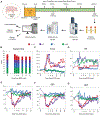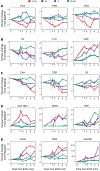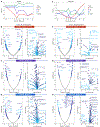Omics Signatures of Tissue Injury and Hemorrhagic Shock in Swine
- PMID: 37334680
- PMCID: PMC10728352
- DOI: 10.1097/SLA.0000000000005944
Omics Signatures of Tissue Injury and Hemorrhagic Shock in Swine
Abstract
Objective: Advanced mass spectrometry methods were leveraged to analyze both proteomics and metabolomics signatures in plasma upon controlled tissue injury (TI) and hemorrhagic shock (HS)-isolated or combined-in a swine model, followed by correlation to viscoelastic measurements of coagulopathy via thrombelastography.
Background: TI and HS cause distinct molecular changes in plasma in both animal models and trauma patients. However, the contribution to coagulopathy of trauma, the leading cause of preventable mortality in this patient population remains unclear. The recent development of a swine model for isolated or combined TI+HS facilitated the current study.
Methods: Male swine (n=17) were randomized to either isolated or combined TI and HS. Coagulation status was analyzed by thrombelastography during the monitored time course. The plasma fractions of the blood draws (at baseline; end of shock; and at 30 minutes, 1, 2, and 4 hours after shock) were analyzed by mass spectrometry-based proteomics and metabolomics workflows.
Results: HS-isolated or combined with TI-caused the most severe omic alterations during the monitored time course. While isolated TI delayed the activation of coagulation cascades. Correlation to thrombelastography parameters of clot strength (maximum amplitude) and breakdown (LY30) revealed signatures of coagulopathy which were supported by analysis of gene ontology-enriched biological pathways.
Conclusion: The current study provides a comprehensive characterization of proteomic and metabolomic alterations to combined or isolated TI and HS in a swine model and identifies early and late omics correlates to viscoelastic measurements in this system.
Copyright © 2023 Wolters Kluwer Health, Inc. All rights reserved.
Conflict of interest statement
A.D. and K.C.H. are founders of Omix Technologies Inc. A.D. is also a founder of Altis Biosciences LLC., A.D. is a consultant for Macopharma Inc. A.D. and C.C.S. are both consultants for Hemanext Inc. E.E.M. has received research support from Haemonetics, Werfen, Hemosonics, Stago, Diapharma, and Prytime. The remaining authors report no conflicts of interest.
Figures







Similar articles
-
Hemorrhagic shock and tissue injury provoke distinct components of trauma-induced coagulopathy in a swine model.Eur J Trauma Emerg Surg. 2023 Apr;49(2):1079-1089. doi: 10.1007/s00068-022-02148-x. Epub 2022 Nov 1. Eur J Trauma Emerg Surg. 2023. PMID: 36319860 Free PMC article.
-
FFP maintains normal coagulation while Kcentra induces a hypercoagulable state in a porcine model of pulmonary contusion and hemorrhagic shock.J Trauma Acute Care Surg. 2022 Jul 1;93(1):124-129. doi: 10.1097/TA.0000000000003584. Epub 2022 Mar 7. J Trauma Acute Care Surg. 2022. PMID: 35261373
-
Thrombelastography indicates limitations of animal models of trauma-induced coagulopathy.J Surg Res. 2017 Sep;217:207-212. doi: 10.1016/j.jss.2017.05.027. Epub 2017 May 11. J Surg Res. 2017. PMID: 28583756 Free PMC article.
-
Coagulation challenges after severe injury with hemorrhagic shock.J Trauma Acute Care Surg. 2012 Jun;72(6):1714-8. doi: 10.1097/TA.0b013e318245225c. J Trauma Acute Care Surg. 2012. PMID: 22695446 Review.
-
Postinjury coagulopathy management: goal directed resuscitation via POC thrombelastography.Ann Surg. 2010 Apr;251(4):604-14. doi: 10.1097/SLA.0b013e3181d3599c. Ann Surg. 2010. PMID: 20224372 Review.
Cited by
-
Increase in plasma succinate is associated with aerobic lactate production in a model of endotoxic shock.Exp Physiol. 2025 Apr;110(4):550-560. doi: 10.1113/EP092109. Epub 2025 Mar 19. Exp Physiol. 2025. PMID: 40106454 Free PMC article.
-
Navigating Hemorrhagic Shock: Biomarkers, Therapies, and Challenges in Clinical Care.Biomedicines. 2024 Dec 17;12(12):2864. doi: 10.3390/biomedicines12122864. Biomedicines. 2024. PMID: 39767770 Free PMC article. Review.
References
Publication types
MeSH terms
Grants and funding
LinkOut - more resources
Full Text Sources
Medical

